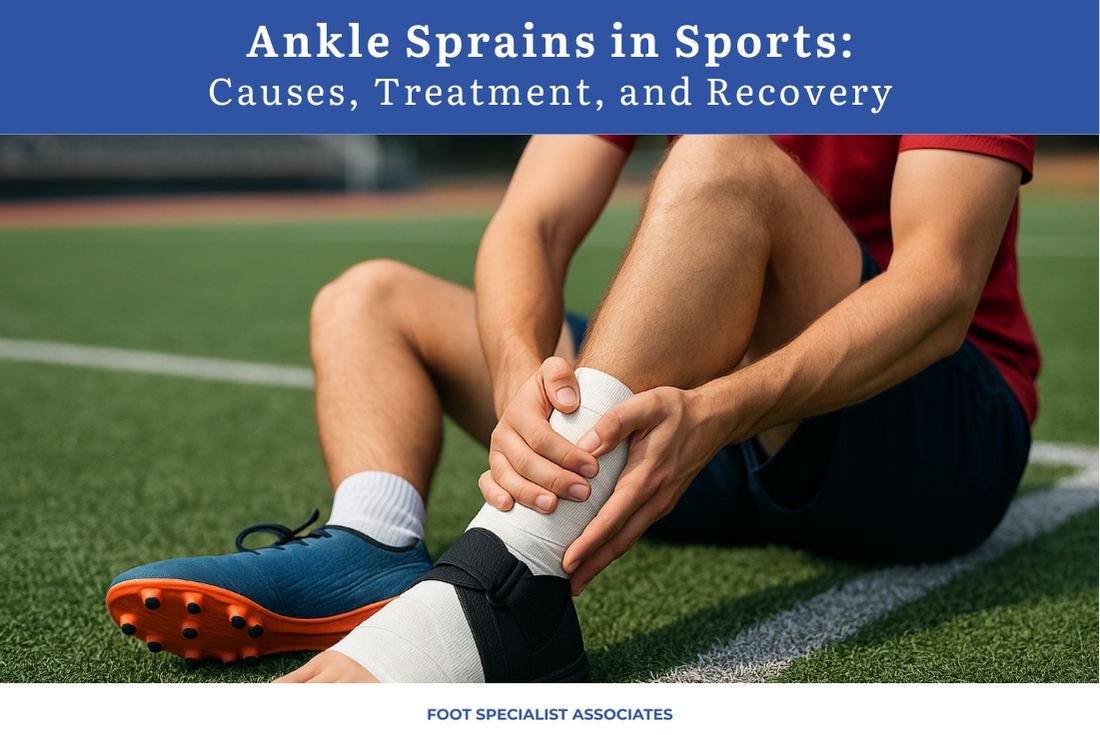Whether you’re an athlete, a weekend warrior, or simply enjoy staying active, ankle sprains are one of the most common sports-related injuries. While they may seem minor, improper care can lead to chronic instability, long-term pain, and repeat injuries. At Foot Specialist Associates, we specialize in diagnosing, treating, and preventing ankle sprains so you can get back to doing what you love—safely.
What is an Ankle Sprain?
An ankle sprain occurs when the ligaments—strong bands of tissue that stabilize your ankle—are stretched or torn. This usually happens when the ankle twists, rolls, or turns beyond its normal range of motion, often during sports or physical activity.
Common Causes of Sports-Related Ankle Sprains
- Sudden changes in direction while running
- Jumping and landing awkwardly
- Playing on uneven surfaces
- Contact injuries from other players
- Wearing improper footwear for the activity
Symptoms to Watch For
- Pain, especially when bearing weight
- Swelling and tenderness around the ankle
- Bruising or discoloration
- Reduced range of motion
- A feeling of instability or “giving way”
Treatment Options at Foot Specialist Associates
Our goal is to reduce pain, promote healing, and prevent future injury. Depending on the severity, we may recommend:
- RICE Method (Rest, Ice, Compression, Elevation) – For mild sprains, this reduces swelling and promotes recovery.
- Supportive Bracing or Taping – To stabilize the joint while healing.
- Custom Orthotics – To improve foot and ankle alignment.
- Physical Therapy – To restore strength, balance, and flexibility.
- Advanced Imaging – Such as X-rays or MRI to rule out fractures or severe ligament damage.
- Regenerative / Advanced Nonoperative Therapies – such as shockwave therapy (ESWT), PRP / stem cell injections, or dry needling
- Minimally Invasive Surgery – In rare, severe cases where ligaments are completely torn.
Prevention Tips for Athletes
- Always warm up before exercise
- Wear supportive shoes designed for your sport
- Strengthen ankle and calf muscles
- Practice balance training
- Avoid playing through pain
Comprehensive Q&A on Ankle Sprains
Q: How long does it take to recover from a sprained ankle?
A: Mild sprains may heal within 1–3 weeks, while more severe injuries can take 6–12 weeks. Chronic instability may require longer rehabilitation.
Q: Should I see a doctor for every ankle sprain?
A: Yes—especially if you can’t put weight on the ankle, swelling is severe, or symptoms don’t improve within a few days. Even mild sprains can hide more serious injuries.
Q: Can untreated ankle sprains cause long-term problems?
A: Absolutely. Without proper treatment, you risk chronic pain, instability, arthritis, and repeated injuries.
Q: How can I tell if it’s broken or just sprained?
A: Both can cause pain, swelling, and bruising. A professional exam and imaging can confirm the diagnosis.
Q: When can I return to sports after a sprain?
A: Return only after your doctor confirms your ankle is strong, stable, and pain-free. Rushing back too soon increases your risk of re-injury.
Why Choose Foot Specialist Associates?
We combine advanced diagnostic tools, personalized treatment plans, and sports medicine expertise to ensure the best outcomes for our patients. Our team works with athletes of all levels—from high school competitors to professional players—to get them back on the field safely.
Contact Foot Specialist Associates
Address: 950 E. Harvard Avenue, Suite 300, Denver, CO 80210
Phone: (303) 722-6864
If you’ve suffered an ankle sprain, don’t wait for it to heal on its own. Contact us today to schedule your evaluation and get expert care tailored to your needs.
